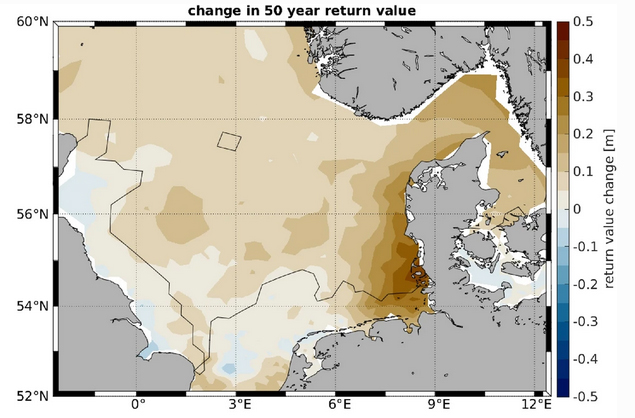Global warming leads to higher storm surges in the German Bight
Extreme storm surges are among the weather phenomena with the greatest damage potential along the German North Sea coast. For coastal protection the question thus arises as to how the expected level of extreme storm surges will change as a result of anthropogenic climate change. It is clear that the expected rise in mean sea level (mainly due to the warming-related expansion of sea water and the melting of glaciers and ice sheets) will directly lead to higher storm surges; however, it is unclear whether a relative change in storm surge levels can additionally be expected (such as a shift in storm conditions). From a coastal protection point of view, this is especially interesting for particularly strong storm surges, which statistically only occur once every decade or less frequently and thus have the highest damage potential. Yet, due to their rarity and high temporal variability, previous studies have not been able to make any statistically significant statements about their change signal. On the one hand, the computing effort for climate simulations with a sufficient number of simulation years using high-resolution regional models was too complex. On the other hand, available global climate simulations with many realizations of marginally different initial conditions (“ensembles”) cannot adequately resolve the temporal and spatial course of such storm surges.
Using numerical ensemble simulations of a special regionally coupled climate model (REMO / MPIOM), the authors have now investigated the climate change signal of such extreme storm surges. The advantage of this model setup is that it consists of a regional atmosphere model with a higher resolution than the global climate model (important for simulating extreme water levels due to storm surges) and a global ocean model (important for a consistent simulation of the global climate) with a regional grid refinement (important for the simulation storm surges). This approach allows the authors to adequately simulate the complex physics of storm surges in the North Sea on the one hand and to generate a large number of simulation years on the other hand, so that the climate change signal can be separated from internal variability even for particularly extreme storm surges.
They found that the large winter storm surges are projected to become even stronger in a significantly warmer climate, while the comparatively moderate summer storm surges, on the other hand, will tend to decrease. This is primarily due to a seasonally opposite future change in storm conditions along the North Atlantic storm belt. The change signal of the stronger winter storm surges is in the order of up to 50% of the signal of the sea level rise expected by the end of the century. The largest increase is projected to occur on the western coast of Schleswig-Holstein. This implies that disregarding the relative change in storm surge heights on top of mean sea level rise (as often assumed in coastal protection) could lead to a considerable underestimation of changes in absolute storm surge heights in the future. Accordingly, a storm surge in the German Bight, which has statistically occurred every 50 years so far, could occur every 2-5 years at the end of the 21st century if anthropogenic CO2 emissions are not to be reduced significantly.

Original publication:
Lang, A. & Mikolajewicz, U. (2020) Rising extreme sea levels in the German Bight under enhanced CO2 levels: a regionalized large ensemble approach for the North Sea. Climate Dynamics, online available. doi:10.1007/s00382-020-05357-5
Contact:
Dr Andreas Lang
Email: andreas.lang@mpimet.mpg.de
Uwe Mikolajewicz
Max Planck Institute for Meteorology
Phone: +49 (0) 40 41173 243
Email: uwe.mikolajewicz@mpimet.mpg.de
